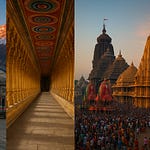Murudeshwar Temple is a renowned Hindu pilgrimage site dedicated to Lord Shiva, situated in the coastal town of Murudeshwar, Uttara Kannada district, Karnataka, India. Nestled between the Arabian Sea and the Western Ghats, the temple is famous for its massive 123-feet Shiva statue, the second tallest in the world, and a 237-feet high Rajagopuram (temple tower) that dominates the skyline.
This temple is steeped in Hindu mythology, particularly the legend of the Atma Linga, which connects it to the great epic Ramayana. Apart from its spiritual significance, Murudeshwar offers breathtaking views, making it a perfect blend of divinity, history, architecture, and natural beauty.
Historical and Mythological Significance
Murudeshwar’s origins are deeply rooted in Hindu mythology, particularly the legend of Ravana, the demon king of Lanka, and his quest for immortality.
1. The Legend of the Atma Linga
According to the Ramayana, Ravana, an ardent devotee of Lord Shiva, performed severe penance to obtain the Atma Linga (Soul of Shiva). Pleased by his devotion, Lord Shiva granted him this powerful Linga, which had the ability to make Ravana invincible.
However, Lord Vishnu, realizing the potential consequences of Ravana becoming invincible, devised a plan to prevent him from carrying the Linga to Lanka. He requested Lord Ganesha to intervene.
As Ravana reached Gokarna, he needed to perform his evening prayers. He entrusted the Atma Linga to a young Brahmin boy (Lord Ganesha in disguise), instructing him not to place it on the ground. Ganesha, tricking Ravana, placed the Linga on the ground, making it impossible to move.
In his fury, Ravana tried to destroy the Linga, scattering its pieces across Karnataka.
The main part of the Linga remained in Gokarna (Mahabaleshwar Temple).
A fragment fell in Murudeshwar, giving the place its name (‘Murudu’ means ‘remnant’ and ‘Ishwara’ means ‘Shiva’).
This event solidified Murudeshwar as a sacred site of worship for Lord Shiva devotees.
Religious Importance and Spiritual Significance
Murudeshwar Temple is one of the holiest sites for Shaivites (followers of Shiva) and attracts millions of devotees seeking blessings, spiritual enlightenment, and peace.
1. The Power of the Atma Linga
It is believed that praying at Murudeshwar Temple, combined with a visit to Gokarna, grants devotees health, prosperity, and salvation (Moksha).
2. Murudeshwar as a Moksha Dham
According to Hindu beliefs, worshipping Lord Shiva at Murudeshwar with devotion washes away sins and helps attain liberation (Moksha) from the cycle of rebirth.
3. Maha Shivaratri – The Grand Festival
Murudeshwar sees its largest gathering during Maha Shivaratri, when thousands of devotees perform special prayers, fasting, and night-long vigils in honor of Lord Shiva.
Pujas and Rituals at Murudeshwar Temple
Murudeshwar Temple follows traditional Vedic rituals and prayers dedicated to Lord Shiva.
1. Daily Pujas and Darshan
Ushakala Pooja (Morning Pooja) – Worship at sunrise.
Madhyahna Pooja (Midday Pooja) – Ritual bathing (Abhishekam) of the Shiva Linga.
Sandhya Pooja (Evening Worship) – Aarti and chanting of sacred Shiva mantras.
2. Special Rituals
Abhishekam (Holy Bathing of the Linga): Using milk, honey, ghee, and holy water.
Rudrabhishekam: A sacred recitation of Rudram and Chamakam for blessings.
Maha Mrityunjaya Homa: A powerful fire ritual for longevity and protection.
Bilva Archana: Offering Bilva leaves, which are dear to Lord Shiva.
Pradakshina: Devotees circumambulate the temple in a clockwise direction as a mark of respect.
Architectural Splendor of Murudeshwar Temple
The temple is a blend of Dravidian and modern South Indian architectural styles, boasting intricate carvings and towering structures.
1. The 237-feet Rajagopuram (Entrance Tower)
One of the tallest temple towers in India, standing at 20 stories.
Devotees can take an elevator to the top for aerial views of the Arabian Sea, Shiva statue, and temple complex.
2. The Iconic 123-feet Shiva Statue
The second tallest Shiva statue in the world.
Positioned to reflect sunlight, enhancing its divine radiance.
Surrounded by elaborate sculptures depicting Shiva’s stories from Hindu mythology.
3. Cave Museum
Below the Shiva statue is a cave museum, featuring beautifully crafted idols that depict the legend of Ravana and the Atma Linga.
Murudeshwar: More Than Just a Temple - A Devotee's Experience
Murudeshwar Temple is not just a place of worship; it is a sacred experience that stays with devotees long after they leave. The serene atmosphere, the sound of waves crashing against the temple walls, and the divine aura of Lord Shiva’s presence create an unparalleled spiritual journey.
Devotee Experience: What to Expect When You Visit
1. The Entrance and First Impressions
As you approach the temple, the towering Rajagopuram and the massive Shiva statue leave you in awe. The intricate carvings and Dravidian architecture immediately transport you to a divine realm.
Many devotees walk barefoot as a sign of respect.
You may notice people offering prayers at small shrines around the temple.
The temple bells ring, adding to the divine energy of the place.
2. Darshan and Rituals
Inside the temple, the main sanctum (Garbhagriha) houses the Shiva Linga, where priests perform Abhishekam (ritual bathing).
Expect a queue during peak hours, especially on Mondays and Maha Shivaratri.
Devotees chant ‘Om Namah Shivaya’ while waiting for their turn to offer prayers.
The temple priests perform special poojas for those who pre-book rituals.
3. Witnessing the Grand Aarti
One of the most mesmerizing experiences at Murudeshwar is the evening aarti.
The entire temple is lit up, and the sound of conch shells and mantras fills the air.
The waves of the Arabian Sea reflect the temple lights, creating a magical view.
Devotees experience a deep sense of peace and connection with Lord Shiva.
4. Climbing the Rajagopuram for a Bird’s Eye View
The 20-story Rajagopuram has an elevator, allowing visitors to reach the top floor.
From here, you get a panoramic view of the temple, Shiva statue, and the endless Arabian Sea.
It’s an excellent spot for photography and spiritual reflection.
The Spiritual Essence of Murudeshwar
1. A Place of Moksha and Healing
Many devotees believe that prayers at Murudeshwar help cleanse past sins and bring peace to the soul. People suffering from illness, mental stress, and financial problems often visit the temple seeking Lord Shiva’s blessings.
2. A Temple That Stands Between the Ocean and the Sky
Unlike many inland Shiva temples, Murudeshwar is surrounded by water on three sides. This unique positioning gives a feeling of being closer to the divine, as if Lord Shiva himself is watching over the sea.
3. The Union of Devotion and Nature
The temple’s location on the coastline symbolizes harmony between spirituality and the natural world.
The soothing ocean breeze and the sound of waves enhance the meditative experience.
Beyond Worship: Cultural and Social Aspects
Murudeshwar Temple is not only a religious site but also a hub for cultural activities, spiritual retreats, and religious gatherings.
1. Murudeshwar as a Spiritual Retreat
Many devotees spend days meditating near the temple, seeking enlightenment.
The temple surroundings provide peaceful spots for yoga and self-reflection.
Devotional songs and bhajans are often performed by groups of devotees.
2. The Role of Murudeshwar in Karnataka’s Religious Tourism
The temple attracts both pilgrims and tourists, boosting local commerce and hospitality.
Many spiritual tours include Murudeshwar along with Gokarna, Udupi, and Kollur Mookambika Temple.
3. A Center for Shaivite Traditions
The temple serves as a learning center for Shaivite traditions and scriptures.
Scholars and religious teachers hold discourses and storytelling sessions based on Shiva Purana and Ramayana.
Travel Guide for Devotees
1. How to Reach Murudeshwar
By Air: Mangalore International Airport (160 km away).
By Rail: Murudeshwar Railway Station connects to Mumbai, Mangalore, Bangalore.
By Road: Located along NH-66 (Mumbai-Goa-Kochi highway), well connected by buses and taxis.
2. Best Time to Visit
October to March – Pleasant weather.
Maha Shivaratri – Best time to witness the grand celebration.
3. Accommodation Options
RNS Residency (overlooking the Arabian Sea).
Temple Guest Houses (affordable stay for pilgrims).
Practical Information for Visitors
1. Entry and Timings
Temple Timings: 6:00 AM – 12:30 PM & 3:00 PM – 8:15 PM
Aarti Timings: Morning (6:00 AM) and Evening (6:30 PM)
2. Dress Code
Men: Recommended to wear traditional attire (dhoti or kurta-pajama).
Women: Saree, salwar kameez, or decent Indian wear is preferred.
Prohibited: Shorts, sleeveless tops, and western casual wear.
3. Special Tips for Devotees
Arrive early in the morning to avoid crowds and experience peaceful darshan.
Pre-book poojas if you wish to perform special rituals.
Respect temple rules (no photography inside the sanctum, silence in sacred areas).
Nearby Attractions for Pilgrims and Tourists
1. Netrani Island
A beautiful island 20 km from Murudeshwar.
Famous for scuba diving and snorkeling.
2. Gokarna (78 km away)
Home to the Mahabaleshwar Temple, another important Shiva temple.
Popular for pristine beaches and spiritual retreats.
3. Jog Falls (88 km away)
India’s second-highest plunge waterfall, a breathtaking natural wonder.
Why Visit Murudeshwar Temple?
✅ Spiritual Experience – One of the most powerful Shiva temples with deep mythological roots.
✅ Stunning Architecture – Features one of the tallest Gopurams and the second largest Shiva statue.
✅ Coastal Beauty – Surrounded by the Arabian Sea, creating a serene and picturesque setting.
✅ Pilgrimage and Adventure – A perfect mix of devotion, history, and scenic travel.
Murudeshwar Temple is a divine destination that bridges faith, history, and architecture. Whether you are a devotee seeking blessings, a traveler exploring heritage, or an architecture enthusiast, this temple offers an unparalleled experience of devotion and beauty.
For a true spiritual awakening and mesmerizing views, Murudeshwar Temple is a must-visit! 🌿🙏










